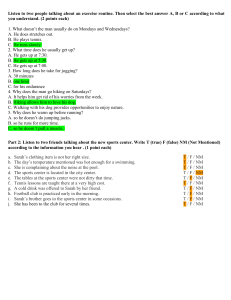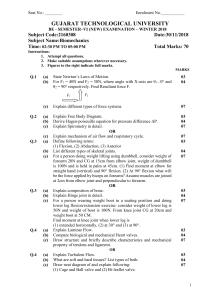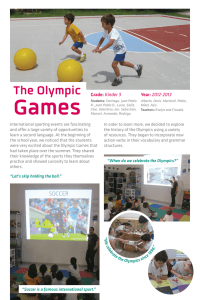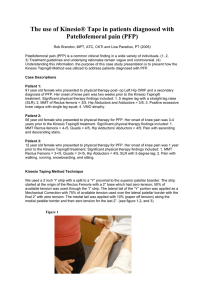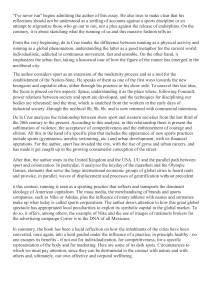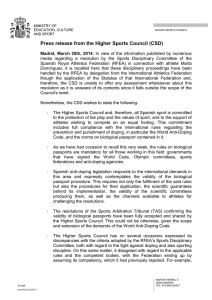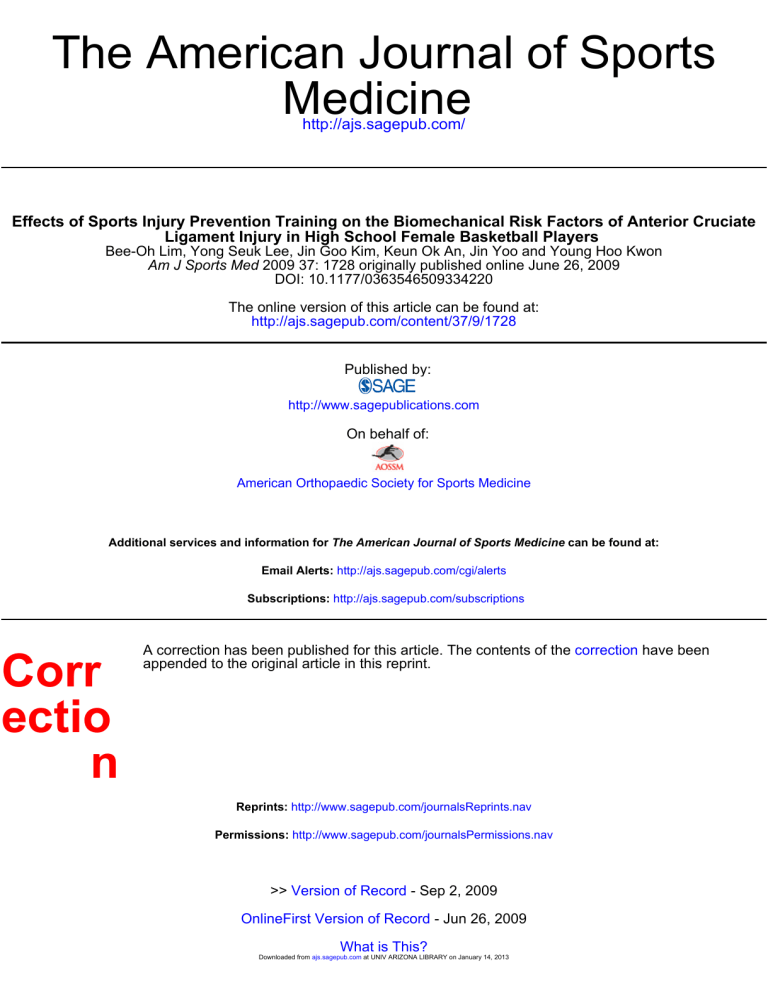
The American Journal of Sports Medicine http://ajs.sagepub.com/ Effects of Sports Injury Prevention Training on the Biomechanical Risk Factors of Anterior Cruciate Ligament Injury in High School Female Basketball Players Bee-Oh Lim, Yong Seuk Lee, Jin Goo Kim, Keun Ok An, Jin Yoo and Young Hoo Kwon Am J Sports Med 2009 37: 1728 originally published online June 26, 2009 DOI: 10.1177/0363546509334220 The online version of this article can be found at: http://ajs.sagepub.com/content/37/9/1728 Published by: http://www.sagepublications.com On behalf of: American Orthopaedic Society for Sports Medicine Additional services and information for The American Journal of Sports Medicine can be found at: Email Alerts: http://ajs.sagepub.com/cgi/alerts Subscriptions: http://ajs.sagepub.com/subscriptions Corr ectio n A correction has been published for this article. The contents of the correction have been appended to the original article in this reprint. Reprints: http://www.sagepub.com/journalsReprints.nav Permissions: http://www.sagepub.com/journalsPermissions.nav >> Version of Record - Sep 2, 2009 OnlineFirst Version of Record - Jun 26, 2009 What is This? Downloaded from ajs.sagepub.com at UNIV ARIZONA LIBRARY on January 14, 2013 Effects of Sports Injury Prevention Training on the Biomechanical Risk Factors of Anterior Cruciate Ligament Injury in High School Female Basketball Players Bee-Oh Lim,* PhD, Yong Seuk Lee,†‡ MD, Jin Goo Kim,§ MD, Keun Ok An,ll MS, ¶ # Jin Yoo, PhD, and Young Hoo Kwon, PhD ‡ From *Sports Science Institute, Seoul National University, Seoul, Korea, Department of § Orthopaedic Surgery, Korea University Ansan Hospital, Ansan, Korea, Department of ll Orthopedic Surgery, Seoul Paik Hospital, Inje University, Seoul, Department of Physical ¶ Education, Dankook University, Seoul, Department of Physical Education, Chung Ang # University, Seoul, and Department of Kinesiology, Texas Woman’s University, Denton, Texas Background: Female athletes have a higher risk of anterior cruciate ligament injury than their male counterparts who play at similar levels in sports involving pivoting and landing. Hypothesis: The competitive female basketball players who participated in a sports injury prevention training program would show better muscle strength and flexibility and improved biomechanical properties associated with anterior cruciate ligament injury than during the pretraining period and than posttraining parameters in a control group. Study Design: Controlled laboratory study. Methods: A total of 22 high school female basketball players were recruited and randomly divided into 2 groups (the experimental group and the control group, 11 participants each). The experimental group was instructed in the 6 parts of the sports injury prevention training program and performed it during the first 20 minutes of team practice for the next 8 weeks, while the control group performed their regular training program. Both groups were tested with a rebound-jump task before and after the 8-week period. A total of 21 reflective markers were placed in preassigned positions. In this controlled laboratory study, a 2-way analysis of variance (2 × 2) experimental design was used for the statistical analysis (P < .05) using the experimental group and a testing session as within and between factors, respectively. Post hoc tests with Sidak correction were used when significant factor effects and/or interactions were observed. Results: A comparison of the experimental group’s pretraining and posttraining results identified training effects on all strength parameters (P = .004 to .043) and on knee flexion, which reflects increased flexibility (P = .022). The experimental group showed higher knee flexion angles (P = .024), greater interknee distances (P = .004), lower hamstring-quadriceps ratios (P = .023), and lower maximum knee extension torques (P = .043) after training. In the control group, no statistical differences were observed between pretraining and posttraining findings (P = .084 to .873). At pretraining, no significant differences were observed between the 2 groups for any parameter (P = .067 to .784). However, a comparison of the 2 groups after training revealed that the experimental group had significantly higher knee flexion angles (P = .023), greater knee distances (P = .005), lower hamstringquadriceps ratios (P = .021), lower maximum knee extension torques (P = .124), and higher maximum knee abduction torques (P = .043) than the control group. Conclusion: The sports injury prevention training program improved the strength and flexibility of the competitive female basketball players tested and biomechanical properties associated with anterior cruciate ligament injury as compared with pretraining parameters and with posttraining parameters in the control group. Clinical Relevance: This injury prevention program could potentially modify the flexibility, strength, and biomechanical properties associated with ACL injury and lower the athlete’s risk for injury. Keywords: anterior cruciate ligament (ACL); female; biomechanical deficit; injury prevention program † Address correspondence to Yong Seuk Lee, MD, Department of Orthopaedic Surgery, Korea University Ansan Hospital, 516 Gozan-1-dong, Danwon-gu, Ansan 425-707, Korea (e-mail: smcos1@hanmail.net). No potential conflict of interest declared. The American Journal of Sports Medicine, Vol. 37, No. 9 DOI: 10.1177/0363546509334220 © 2009 The Author(s) 1728 Downloaded from ajs.sagepub.com at UNIV ARIZONA LIBRARY on January 14, 2013 Injury Prevention Training and Risk of ACL Injury 1729 Vol. 37, No. 9, 2009 Female athletes have a 4- to 6-fold higher risk of anterior cruciate (ACL) injury than their male counterparts who play the same sports at similar levels.1,10,19 An increased ACL injury risk coupled with an increase in sports participation by young women has fueled many genderspecific mechanistic and interventional investigations.10 The mechanism underlying gender disparity of ACL injury risk is likely multifactorial in nature, and several theories have been proposed to explain the phenomenon.12 These theories include related extrinsic variables (physical and visual perturbations, bracing, and shoe-surface interactions) and intrinsic variables (anatomic, hormonal, neuromus­ cular, and biomechanical differences between genders).10 The biomechanical risk factors that appear to play a major role in noncontact ACL injuries are greater knee extension and valgus moments during the landing phase of a jumpand-stop task,4,17 less knee flexion and more hip and knee internal rotation than male athletes during single-legged landings,14 and greater dependence on the quadriceps to stabilize the knee as compared with male athletes.15 With regard to environmental, anatomic, and hormonal risk factors, there is no conclusive evidence that these factors are directly correlated with an elevated risk of ACL injury in female athletes. Furthermore, most of these factors are congenital factors and are not easily controlled.6 Therefore, emphasis has turned to physical and biomechanical risk factors and the use of neuromuscular and proprioceptive intervention programs to address potential deficits.4,14-17 Most prevention programs target modifying dynamic loading through neuromuscular training. Mandelbaum et al16 reported that neuromuscular training programs reduce ACL injuries in female athletes, and the primary goal of their training program was to address feed-forward mechanisms to allow external forces to be better anticipated or to load and stabilize the joint.16 However, in this previous report, only the incidences of ACL injuries after a training program were reported. Our injury prevention program is a modification of the one used by Mandelbaum et al, and we undertook to evaluate its effect on muscle strength, flexibility, and biomechanical properties. The hypothesis of this study was that competitive female basketball players who participated in our sports injury prevention training program (SIPTP) would show increased muscle strength, flexibility, and improved biomechanical properties as compared with their pretraining values and with posttraining values in a control group. The purpose of this study was to determine whether our injury prevention program is effective at increasing the muscle strength and flexibility of competitive female basketball players and improving biomechanical properties related to ACL injury. This was evaluated by measuring differences between parameters in an experimental group’s pre-and posttraining and between the experimental group’s and the control group’s posttraining results. MATERIALS AND METHODS Participants A total of 22 high school female basketball players between 15 and 17 years of age were recruited from 2 teams in the same area; participants had no known history of lower extremity injuries. Participants were randomly divided into 2 groups. From the 22 athletes, we chose 7 (height, 171.3 ± 6.9 cm; body mass, 63.9 ± 5.3 kg; age, 17.1 ± 1.1 years) randomly for a reliability test. Four participants were from the experimental group and 3 were from the control group. The mean age of the experimental group was 16.2 ± 1.2 years, mean height 172.2 ± 5.3 cm, and mean body mass 64.2 ± 6.1 kg; corresponding values in the control group were 16.1 ± 1.0 years, 170.9 ± 7.6 cm, and 64.0 ± 7.3 kg. There were no significant differences between the 2 groups with regard to their mean age, height, and weight. Our institutional internal review board approved the use of human subjects for this study. Written consent was obtained from each of the study participants and from their parents or guardians. Data Collection In the rebound jump task, the participant was instructed to vertical jump maximally to catch the ball under the ceiling and land on the force plate. A successful trial was defined as a trial in which the participant performed the rebound task as instructed and videographic and analog data were successfully collected. Pretraining data were collected before training sessions in both groups, and posttraining data immediately after the completion of the 8-week training period. Three-dimensional motion analyses of the landing phase of the rebound jump were conducted to measure selected kinematic and kinetic variables, which included jump height, maximum knee flexion angle, minimum interknee distance, maximum knee internal rotation angle, maximum knee extension moment, and maximum knee valgus moment. Six video cameras (Panasonic AG-D5100, Panasonic Corp, Osaka, Japan) and 2 force plates (AMTI ORG-6, AMTI, Watertown, Massachusetts) were used during the motion analysis. Each camera was calibrated with a calibration frame (2 m long × 1.5 m wide × 2 m high) before data collection. In addition, 2 pairs of electrodes (1 cm in diameter, 3 cm center-to-center distance) were placed on the quadriceps (rectus femoris) and hamstring (biceps femoris) muscles, respectively, to monitor the activities of these muscles. Both the force plate and electromyographic (EMG) data were collected at 1200 Hz, whereas video data were captured at 60 fields/s. Kwon3D Version 3.1 (Visol, Seoul, Korea), KwonGRF Version 2.0 (Visol), and MyoResearch Version 1.04 (Noraxon, Scottsdale, Arizona) were used for collecting motion, ground-reaction, and EMG data, respectively. During the data collection sessions, the participants were asked to wear sports bras, spandex pants, and comfortable basketball shoes. Spherical reflective markers were placed at selected locations on the lower extremities and the pelvis: toes (second), heels, lateral malleoli, medial malleoli, lateral shanks, lateral epicondyles, medial epicondyles, lateral thighs, greater trochanters, anterior superior iliac spines (ASIS), and sacrum (Figure 1). The lateral shank and thigh markers were placed on the lateral aspects of the midshank and thigh, respectively, on the line connecting the proximal and distal joints of the respective segments projected to the sagittal plane. A static trial Downloaded from ajs.sagepub.com at UNIV ARIZONA LIBRARY on January 14, 2013 1730 Lim et al The American Journal of Sports Medicine Figure 1. Static marker set: 21 reflective markers were placed at the right and left toe, right and left heel, right and left lateral malleolus, right and left medial malleolus, right and left midshank, right and left lateral epicondyle, right and left medial epicondyle, right and left mid thigh, right and left greater trochanter, right and left anterior superior iliac spines (ASIS), and the sacrum for the 3-dimentional kinematic data. (upright standing position with arms folded on the chest and feet 20 cm apart) was performed on each participant during each testing session to establish the relative positions of joint centers (hip, knee, and ankle) with respect to surface markers and the relative orientations of segmental reference frames to the global (laboratory) reference frame. Medial epicondyle and malleolus markers and greater trochanter markers were subsequently removed in the dynamic (rebound jump) trials. To compute resultant joint moments in each leg, the rebound jump task was performed on 2 separate force plates embedded in the floor, and this was followed by a 2-footed landing on the respective plates (Figure 2). Training Protocol The SIPTP for this study consists of 6 parts (Table 1) and was a modification of Mandelbaum’s Prevent Injury and Enhance Performance (PEP) Program.16 The correct training technique was demonstrated to coaches and players during a 1.5-hour training session, which was Figure 2. To compute the resultant joint moments of joints in each leg, the rebound jump task was performed on 2 separate force plates that were embedded in the floor, and then followed by a 2-footed landing on the respective plates. conducted on practice fields. To encourage compliance and to ensure that exercises were performed correctly, trained personnel (athletic trainers) were present at all training sessions and corrected the techniques of the experimental group participants as needed. During the 8 weeks, the athletic trainer performed 3 follow-up checks (at 2, 4, and 6 weeks) to ensure that exercises were being performed correctly, and helped to encourage compliance by repeating the 1.5-hour training session. The experimental group performed the SIPTP during the first 20 minutes of their regular team basketball practice for the next 8 weeks, while the control group performed their regular training program for the next 8 weeks. Data Processing Three-dimensional (3-D) marker coordinates were computed from the 2-D image coordinates of markers and camera parameters. Marker coordinates were subject to digital filtering using a fourth-order zero phase-lag Butterworth low-pass filter with a cutoff frequency of 12 Hz before computing positional data. The position of hip joint center was computed based on those of the ASIS (right and left), sacrum, and greater trochanter markers as detailed in the Downloaded from ajs.sagepub.com at UNIV ARIZONA LIBRARY on January 14, 2013 Injury Prevention Training and Risk of ACL Injury 1731 Vol. 37, No. 9, 2009 TABLE 1 Sports Injury Prevention Training Program (SIPTP) Distance Exercise 1. Warm-up Jog line to line Shuttle run (side to side) Backward running 2. Stretching Calf stretch Quadriceps stretch Hamstring stretch Inner thigh stretch Hip flexor stretch 3. Strengthening Walking lunges Russian hamstring Single toe raises 4. Plyometrics Lateral hops over cone Forward/backward hops over cone Single-leg hops over cone Vertical jumps with headers Scissors jump 5. Agilities Shuttle run with forward/backward running Diagonal runs Bounding runs 6. Alternative exercise–warm down Bridging with alternating hip flexion Abdominal crunches Single and double knee to chest (supine) Piriformis stretch–supine Seated butterfly stretch–seated Tylkowsky-Andriacchi hybrid method.2 Knee and ankle joint centers were defined as the midpoints of the medial and lateral epicondyles and malleoli, respectively. Thigh and shank reference frames were defined from the positions of joint centers (hip, knee, and ankle) and lateral markers (lateral thigh and lateral shank). Vectors drawn from distal to proximal joint were used as longitudinal axes, and the plane formed by proximal and distal joints and the corresponding lateral marker was used as the frontal plane. The knee flexion/extension angle and knee internal/external rotation angle were obtained from the relative orientation of the shank reference frame versus thigh reference frame. To do this, the relative orientation angles (Euler angles) of the shank to the thigh were computed based on the rotation sequence of flexion/ extension→adduction/abduction→internal/external rotation. Three-dimensional motion data and groundreaction force data were combined to compute knee flexion/ extension and adduction/abduction moment using the inverse dynamics procedures. These raw EMG data were fullwave rectified and low-pass filtered (Butterworth low-pass filter; cutoff frequency = 10 Hz) to produce a linear envelope. Signals were then integrated. Hamstring-quadriceps (H-Q) 100 yd 100 yd 100 yd Repetitions/Cumulative Time 0-1 min 1-2 min 2-3 min 30 30 30 20 30 sec sec sec sec sec × × × × × 2 2 2 3 2 reps reps reps reps reps (3-4 (4-5 (5-6 (6-7 (7-8 min) min) min) min) min) 3 sets × 10 reps (8-9 min) 3 sets × 10 reps (9-10 min) 2 sets × 30 reps (10-11 min) 20 20 20 20 20 50 yd 50 yd (3 passes) 50 yd reps reps reps reps reps (11-11.5 (11.5-12 (12-12.5 (12.5-13 (13-13.5 min) min) min) min) min) 13.5-14 min 14-14.5 min 14.5-15 min 30 30 30 30 30 reps (15-16 min) sec × 2 reps (16-17 sec × 2 reps (17-18 sec × 2 reps (18-19 sec × 2 reps (19-20 min) min) min) min) ratio (%) was defined as: rectus femoris IEMG [integrated EMG] average/(biceps femoris IEMG average + rectus femoris IEMG average) × 100. Hip flexion, knee flexion, and ankle dorsiflexion were measured to determine range of motion and measure flexibility using a goniometer. This was done by actually measuring the athletes separately from the motion analysis session. Isokinetic strength data were recorded using a Biodex System III dynamometer (Biodex Medical Inc, Shirley, New York) to assess peak torque and average power. The participants performed 5 isokinetic concentric hip abduction, hip extension, and knee flexion repetitions of the dominant limb at 60 deg/s.14 Interknee distance was calculated by measuring distance between right and left knee joint centers in the coronal plane. Statistics The following dependent variables were computed in this study: jump height, maximum knee flexion angle, minimum interknee distance, maximum knee internal rotation angle, maximum knee extension moment, maximum knee valgus moment, and H-Q ratio. This study was a controlled Downloaded from ajs.sagepub.com at UNIV ARIZONA LIBRARY on January 14, 2013 1732 Lim et al The American Journal of Sports Medicine TABLE 2 Changes in Strength and Flexibilitya Pretest Experiment Variable Muscle strength Peak torque (N.m/BW) Average power (W/BW) Peak torque (N.m/BW) Average power (W/BW) Peak torque (N.m/BW) Average power (W/BW) Hip abduction Hip extension Knee flexion Flexibility Hip flexion (deg) Knee flexion (deg) Ankle dorsiflexion (deg) 2.80 0.96 5.51 2.11 2.13 1.74 80.25 121.92 75.08 (0.40) (0.15) (0.56) (0.20) (0.33) (0.28) (12.14) (7.12) (11.08) Posttest Control 2.98 1.05 5.57 2.24 2.21 1.77 78.91 124.09 74.82 Experiment (0.84) (0.30) (1.90) (0.86) (0.31) (0.27) (8.38) (5.03) (10.98) b 3.17 b 1.15 b 7.08 2.82b 2.36b 1.90b 83.36 127.45b 78.82 (0.22) (0.12) (1.11) (0.27) (0.20) (0.11) (5.95) (4.89) (5.95) Control 2.88c (0.45) 1.06c (0.17) 5.60c (0.75) 2.16c (0.55) 2.10c (0.10) 1.76c (0.16) c 73.13 (7.30) 123.13c (3.36) 73.88c (4.32) a Data shown are means, with standard deviation in parentheses. BW, body weight. Statistically significant difference between pre- and posttraining data in the experimental group. c Statistically significant difference between experimental and control group in the posttraining data. b TABLE 3 Changes in Risk Factorsa Pretest Variable Experiment Jump height (cm) Maximum knee flexion angle (deg) Knee distance (cm) Maximum knee internal rotation angle (deg) H-Q ratios (%)b Maximum knee extension torque (N.m) Maximum knee valgus moment (N.m) 22.9 92.66 17.56 4.01 75.09 236.96 11.30 (3.4) (4.34) (2.92) (1.56) (5.69) (39.03) (14.11) Posttest Control 22.4 91.71 18.31 4.55 74.60 220.51 9.35 (4.4) (4.25) (3.66) (4.20) (5.74) (54.14) (7.09) Experiment 23.9 94.27b 20.81b 2.26 67.97b 192.18b 3.89 (1.8) (3.44) (1.37) (3.60) (4.18) (12.37) (5.76) Control 22.7 87.31c 17.73c 4.27 74.20c 228.80c 16.29c (4.8) (5.34) (2.26) (3.36) (5.21) (45.65) (14.15) a Data shown are means, with standard deviation in parentheses. H-Q, hamstring-quadriceps. Statistically significant difference between pre- and posttraining data in the experimental group. c Statistically significant difference between experimental and control group in the posttraining data. b laboratory study and 2-way analyses of variance (2 × 2) were used with the experimental group and testing session as the between and within factors, respectively. Post hoc tests with the Sidak correction were performed when significant factor effects and/or interactions were observed. P values of < .05 were considered statistically significant. RESULTS A power analysis for 2-way analysis of variance (2 groups × testing session) was performed for an effect size of 0.5 based on pilot hip abduction peak torque (0.3-N·m/body weight [BW] difference), hip abduction average power (0.05 W/BW difference), hip extension peak torque (1.4-N·m/BW difference), hip extension average power (0.6-W/BW difference), knee flexion peak torque (0.2-N·m/BW difference), knee flexion average power (0.2-W/BW difference), hip flexion flexibility (10.0° difference), knee flexion flexibility (4.0° difference), ankle dorsiflexion flexibility (5.0° difference), maximum knee flexion angle (1.6° difference), knee distance (2.1-cm difference), H-Q ratios (11.0% difference), maximum knee extension torque (28.0-N.m difference), and maximum knee valgus moment (12.0-N.m difference) using the PASS 2002 program for power analysis by NCSS (Kaysville, Utah). We found that a minimum of 10 participants per group were needed for a power of 94% for P = .05. Initially 24 athletes were included in this study; however, only 22 finished the entire study (a retention rate of 91.7%). Of the 2 athletes who dropped out of this study after the pretest, 1 control group member stopped playing basketball for unknown personal reasons, and the other experimental group participant joined the Junior National Team. Therefore, each group in the end contained 11 female participants. Seven players participated in the reliability assessment of the testing procedure.5 The sessions were held no more than 2 days apart at approximately the same time of day. The reliabilities of knee flexion angle (intraclass correlation coefficient [ICC]= 0.923), knee distance (ICC = 0.910), and knee internal rotation angle (ICC = 0.879) were high for all athletes tested. All trials were successful and results are summarized in Tables 2 and 3. A comparison of the experimental group’s pre- and posttraining results identified training effects on all Downloaded from ajs.sagepub.com at UNIV ARIZONA LIBRARY on January 14, 2013 Injury Prevention Training and Risk of ACL Injury 1733 Vol. 37, No. 9, 2009 There were no statistical differences between the 2 groups with regard to any pretraining parameters (P = .067 to .784). However, when the 2 groups were compared after training, the experimental group had greater knee flexion angle (P = .023), knee distance (P = .005), and maximum knee abduction torque (P = .043); a smaller H-Q ratio (P = .021); and less maximum knee extension torque (P = .124). However, there was no difference in jump height or in maximum knee internal rotation angle after the training program completion (P = .512, .432). Knee Flexion Angle (A) 100 (degrees) 80 60 40 20 0 DISCUSSION Knee Extensor Moment (B) 4 (N-m/kg) 3 2 1 0 --1 Knee Joint Power (C) (Watts/kg) 40 20 0 --20 --40 0 10 20 30 40 50 60 70 80 90 100 % Stance Phase Figure 3. Pretraining (dotted line) and posttraining (solid line) mean knee angle (A), moment (B), and power curves (C) for the stance phase of the rebound task. Moment and power were normalized to body weight. Positive values of power indicate energy generation from concentric muscle actions, and negative values indicate energy absorption through eccentric muscle actions. strength parameters (P = .004 to .043) and on knee flexion, which reflects increased flexibility (P = .022). However, there was no difference in the hip flexion or ankle dorsiflexion with regard to flexibility after the training program was complete (P = .07, .12). With regard to biomechanical risk factors, the experimental group showed an increase in knee flexion angle (P = .024) and knee distance (P = .004), and a decrease in H-Q ratio (P = .023) and maximum knee extension torque (P = .043). However, there were no differences in the jump height (P = .674), maximum knee internal rotation angle (P = .437), or maximum knee abduction torque (P = .256) (Figure 3). In the control group, there were no statistical differences between the pre- and posttraining data for any of the parameters tested (P = .084 to .873). The consequences of ACL injury include both temporary and permanent disability and result in both direct and indirect costs. Anterior cruciate ligament injury may cause absence from work, school, or sports. Implicit to the development of injury prevention programs is the identification of athletes who are at an increased risk for noncontact ACL injuries. Since 1999, many studies have been published on the risk factors for ACL injury and injury biomechanics, and many injury prevention programs have been developed. Furthermore, studies have tried to identify the significant components of effective prevention programs as well as the effect these programs have on what is known regarding injury risk factors and biomechanics.7 Our injury prevention program is composed of 6 parts (warm-up, stretching, strengthening, plyometrics, agility and alternative exercise–warm down). The present study shows that SIPTP improves muscle strength and flexibility and the biomechanical properties associated with ACL injury. We believe that these effects can be attributed to SIPTP because all the training sessions were observed and participants were instructed by 3 well-trained coaches throughout the SIPTP. It would appear that all successful programs contain 1 or more of the following components: traditional stretching and strengthening activities, aerobic conditioning, agilities, plyometrics, and risk awareness training.7 However, intervention programs must be feasible and practical in terms of their applicability to younger populations because compliance is vital. Furthermore, we believe that young athletes are more likely to be compliant when the prevention training is a team activity and requires little additional time on the athlete’s part. The SIPTP has the advantage that it requires little additional time on the athlete’s part as similar programs devised by Mandelbaum et al16 (20 minutes) and Myklebust et al19,20 (15 minutes) because it only requires 20 minutes per training program (from warm-up to the warm-down exercises). Furthermore, injury prevention programs that require substantial time are likely to suffer noncompliance during the competitive season, such as those of Heidt et al8 (60 minutes) and Hewett et al11 (60-90 minutes). Previous studies13,18 have demonstrated that strength training combined with other methods, such as plyometrics, balance, and agility training, alter the biomechanics of the lower extremities, but Herman et al9 showed that strength training alone does not alter knee and hip Downloaded from ajs.sagepub.com at UNIV ARIZONA LIBRARY on January 14, 2013 1734 Lim et al The American Journal of Sports Medicine kinematics and kinetics in female recreational athletes. Neuromuscular training in female athletes has been shown to increase active knee stabilization in the laboratory and to decrease the incidence of ACL injuries among female athletes.11-13,19,20 This training allows female athletes to adapt and protect their ACLs from the high-impulse loading during their performance.12,18 Chappell and Limpisvasti3 reported that the implementation of a neuromuscular training program can alter motor control strategies in select jumping tasks and improve athletic performance measures. These results complement previous epidemiologic studies and suggest that neuromuscular training programs can potentially lower the risk of injury. However, comparatively little investigation has been done to determine the ideal duration of a prevention program. Furthermore, because injuries can occur at the beginning of a training session, it seems reasonable that these programs should be instituted before intense-contact practice sessions start. Some have suggested that athletes need a minimum of 6 weeks of training. Six weeks does correlate with the time frame needed to increase motor recruitment, but it does not correlate with what is needed for muscle hypertrophy or improved endurance.7 However, the programs are effective because they train nerve-muscle factors and perhaps 6 weeks is adequate.7 The present study has several limitations that should be considered. First, because the groups were small, we are uncertain that the results are generalizable to all female basketball players. Second, the evaluation was limited to biomechanical factors. Third, a cause (reduction of biomechanical deficits)–result (decrease of injury incidence) relationship cannot be assumed because the changes in these parameters that correlate with the change in injury rates cannot be demonstrated. Fourth, athlete satisfaction and functional improvements were not addressed during the present study. Finally, all measurements were performed by individuals who participated in the study. CONCLUSION Our SIPTP was found to improve the strengths and flexibilities of competitive female basketball players and to improve biomechanical properties associated with ACL injury as compared with pretraining status and as compared with posttraining parameters in a control group. REFERENCES 1. Arendt E, Dick R. Knee injury patterns among men and women in collegiate basketball and soccer: NCAA data and review of literature. Am J Sports Med. 1995;23:694-701. 2. Bell AL, Pedersen DR, Brand RA. A comparison of the accuracy of several hip center location prediction methods. J Biomech. 1990;23:617-621. 3. Chappell JD, Limpisvasti O. Effect of a neuromuscular training program on the kinetics and kinematics of jumping tasks. Am J Sports Med. 2008;36:1081-1086. 4. Chappell JD, Yu B, Kirkendall DT, Garrett WE. A comparison of knee kinetics between male and female recreational athletes in stop-jump tasks. Am J Sports Med. 2002;30:261-267. 5. Ford KR, Myer GD, Hewett TE. Valgus knee motion during landing in high school female and male basketball players. Med Sci Sports Exerc. 2003;35:1745-1750. 6. Griffin LY, Agel J, Albohm MJ, et al. Noncontact anterior cruciate ligament injuries: risk factors and prevention strategies. J Am Acad Orthop Surg. 2000;8:141-150. 7. Griffin LY, Albohm MJ, Arendt EA, et al. Understanding and preventing noncontact anterior cruciate ligament injuries: a review of the Hunt Valley II meeting, January 2005. Am J Sports Med. 2006;34:1512-1532. 8. Heidt RS Jr, Sweeterman LM, Carlonas RL, Traub JA, Tekulve FX. Avoidance of soccer injuries with preseason conditioning. Am J Sports Med. 2000;28:659-662. 9. Herman DC, Weinhold PS, Guskiewicz KM, Garrett WE, Yu B, Padua DA. The effects of strength training on the lower extremity biomechanics of female recreational athletes during a stop-jump task. Am J Sports Med. 2008;36:733-740. 10. Hewett TE, Ford KR, Myer GD. Anterior cruciate ligament injuries in female athletes, part 2: a meta-analysis of neuromuscular interventions aimed at injury prevention. Am J Sports Med. 2006;34:490-498. 11. Hewett TE, Lindenfeld TN, Riccobene JV, Noyes FR. The effect of neuromuscular training on the incidence of knee injury in female athletes: a prospective study. Am J Sports Med. 1999;27:699-706. 12. Hewett TE, Myer GD, Ford KR. Anterior cruciate ligament injuries in female athletes, part 1: mechanisms and risk factors. Am J Sports Med. 2006;34:299-311. 13. Hewett TE, Stroupe AL, Nance TA, Noyes FR. Plyometric training in female athletes: decreased impact forces and increased hamstring torques. Am J Sports Med. 1996;24:765-773. 14. Lephart SM, Ferris CM, Riemann BL, Myers JB, Fu FH. Gender differences in strength and lower extremity kinematics during landing. Clin Orthop Relat Res. 2002;401:162-169. 15. Malinzak RA, Colby SM, Kirkendall DT, Yi B, Garrett WE. A comparison of knee joint motion patterns between men and women in selected athletic tasks. Clin Biomech (Bristol, Avon). 2001;16:438-445. 16. Mandelbaum BR, Silvers HJ, Watanabe DS, et al. Effectiveness of a neuromuscular and proprioceptive training program in preventing anterior cruciate ligament injuries in female athletes: 2-year follow-up. Am J Sports Med. 2005;33:1003-1010. 17. Markolf KL, Burchfield DM, Shapiro MM, Shepard MF, Finerman GA, Slauterbeck JL. Combined knee loading states that generate high anterior cruciate ligament forces. J Orthop Res. 1995;13:930-935. 18. Myer GD, Ford KR, McLean SG, Hewett TE. The effects of plyometric versus dynamic stabilization and balance training on lower extremity biomechanics. Am J Sports Med. 2006;34:445-455. 19. Myklebust G, Engebretsen L, Braekken IH, Skjolberg A, Olsen OE, Bahr R. Prevention of anterior cruciate ligament injuries in female team handball players: a prospective intervention study over three seasons. Clin J Sport Med. 2003;13:71-78. 20. Myklebust G, Engebretsen L, Braekken IH, Skjolberg A, Olsen OE, Bahr R. Prevention of noncontact anterior cruciate ligament injuries in elite and adolescent female team handball athletes. Instr Course Lect. 2007;56:407-418. For reprints and permission queries, please visit SAGE’s Web site at http://www.sagepub.com/journalsPermissions.nav Downloaded from ajs.sagepub.com at UNIV ARIZONA LIBRARY on January 14, 2013 Erratum Lim BO, Lee YS, Kim JG, An KO, Yoo J, Know YH. Effects of sports injury prevention training on the biomechanical risk factors of anterior cruciate ligament injury in high school female basketball players. Am J Sports Med. 2009;37(9):17281734. (Original DOI: 10.1177/0363546509334220) In the above article, the following sentence on page 1733 should be corrected: However, when the 2 groups were compared after training, the experimental group had greater knee flexion angle (P = .023), knee distance (P = .005), and maximum knee abduction torque (P = .043); a smaller H-Q ratio (P = .021); and less maximum knee extension torque (P = .124). The corrected sentence is as follows: However, when the 2 groups were compared after training, the experimental group had greater knee flexion angle (P = .023) and knee distance (P = .005); a smaller H-Q ratio (P = .021); and less maximum knee extension torque (P = .124) and maximum knee abduction torque (P = .043). The American Journal of Sports Medicine, Vol. 39, No. 3 DOI: 10.1177/0363546511400841 © 2011 The Author(s) NP1 Downloaded from ajs.sagepub.com at UNIV ARIZONA LIBRARY on January 14, 2013

